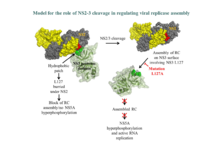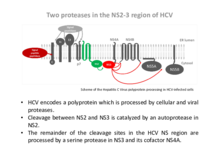Research topic
The genus Hepacivirus: Human hepatitis C virus (HCV)
On the level of genome organization HCV is more closely related to pestiviruses as to the members of genus Flavivirus. World wide about 130 million people suffer from chronic HCV infection. These infections are a major cause for liver cirrhosis and hepatucellular carcinoma. Present concepts of therapy resolve viral pestistence only in a subset of patients. Furthermore, RNA viruses like HCV show a high degree of varialbility. Thus a diverse set of targets for antiviral therapy will be required for eliminating this virus. Accordingly, further investigations aiming at the identification of viral targets as well as antivirals are still necessary. Along these lines, we investigate the two vital proteases encoded in the NS2-3 region of HCV with respect to their function and regulation on molecular level with a special emphasis on the comparison to their pestiviral counterparts.
In previous studies we could demonstrate the cysteine protease in NS2 of HCV displays a basal activity also in the absence of NS3 and thus is a bona fide protease. This basal activity is dramatically increased in presence of the serine protease domain of NS3 located downstream in the polyprotein. For the activation of the NS2 protease the activity of the NS3 serine protease is not required. We could demonstrate that the deletion of an essential part of the NS3 serine protease did not interfere with its ability to activate the NS2 protease. Furthermore, the C terminal part of the NS3 protease domain can contribute efficiently to he activation of the NS2 protease even when supplied in cis.
Current investigations concentrate on the identification of elements in NS3 which are critical for the activation of the NS2 protease and the molecular basis underlying NS2 protease activation.
Research team
Team leader:
Dr. rer. nat. Olaf Isken

Technical staff:
Barbara Bruhn
Julia Larsen



